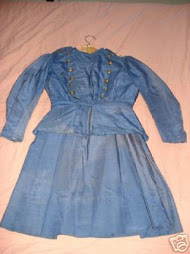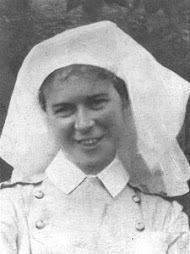Many Canadian voluntary nurses (VADs) served at Canadian Red Cross Headquarters in London during the Great War. Mary MacLeod Moore, in her book The Maple Leaf's Red Cross, described the Canadian Red Cross headquarters this way:
"A day at the Headquarters of the Red Cross told a thrilling story to anyone with ears and eyes. The eagerness to be of use, the enthusiasm and the friendliness of these voluntary workers--for the great majority were voluntary workers--resulted in big things being done...The duties were not all interesting and inspiring. No work is that is done day in and day out...There were some who toiled from first to last, at a sacrifice of comfort and ease and luxury and time...No short and easy hours were allotted to the Red Cross workers. Early and late they were "one the job." Sometimes midnight found them working hard that none who trusted them might be disappointed. You went early in the morning and found the Chief Commissioner beginning his day by talking to officials over the telephone, seeing a constant stream of visitors, offering money, advice, help; reading cables from Canada about some important development or messages from France as to transport and supplies. You found Lady Drummond, in the midst of her workers, keeping her finger on all the departments of the Bureau, and in addition seeing soldiers and civilians bound on a variety of errands, and none was sent away unsatisfied...You saw a roomful of women filing information about wounded Canadians and writing letters to their people at home. [Note: this may have been the work that Aileen Powers-Peel was doing before her death.] You went into another and watched piles of letters being sorted and read, in which comforts were requested for sick and wounded men, or thanks were offered by the men themselves to the O.C. Parcels. You went into another room and women were packing quickly and skilfully these comforts and dainties to cheer up a man in hospital. You turned to the prisoners of War Department and there the workers were sorting letters from the prisoners to their staunch friends, and filing carefully on cards the details concerning them. Plans for their increased comfort were being considered and their families written to cheerfully..."
The Maple Leaf's Red Cross is well worth a read, if you are looking for information about the work of professional military nurses, VADs, and the Canadian Red Cross in general. It is available from Amazon in reprint form, or second hand (try Abebooks.com).
Wednesday, June 24, 2015
VAD Death at the End of the War
The February 1920 issue of The Red Cross Journal included the short mention of the death of a voluntary Red Cross nurse: "We regret to announce the deaths of....Miss Aileen Powers-Peel of the Canadian Imperial Detachment." Aileen was one of five Red Cross deaths that month and she doesn't seem to have merited any further information about her background or how she came to die, at the 31st of December 1918, at only 25 years of age. Everything about Aileen seems to be a mystery. Colleague Bill May brought her to my attention following one of his frequent visits to Great War memorials. He sent me this photo, which piqued my interest and got me digging for more information:
Aileen Powers-Peel was born in Toronto in 1894. While there are almost no details of her early life easily available, it is known that she belonged to the Church of England and her parents were likely Allen and Annie Peel of Kent County, Ontario. During the war, Aileen did secretarial work for Canadian Red Cross Headquarters and was also qualified as a "chauffeuse" (driver). She appears to have taken some leave in April 1918, to return to Canada on the ship Mauretania. Her destination at that time was Ottawa, Ontario. Her next of kin at her death was Mrs. Cook, 31 Centre Street, Galt, Ontario. This was likely her sister. Aileen is buried at the Brookwood Military Cemetery, in Surrey, United Kingdom. If you know more about this nurse please write to me c/o this blog.
Aileen Powers-Peel was born in Toronto in 1894. While there are almost no details of her early life easily available, it is known that she belonged to the Church of England and her parents were likely Allen and Annie Peel of Kent County, Ontario. During the war, Aileen did secretarial work for Canadian Red Cross Headquarters and was also qualified as a "chauffeuse" (driver). She appears to have taken some leave in April 1918, to return to Canada on the ship Mauretania. Her destination at that time was Ottawa, Ontario. Her next of kin at her death was Mrs. Cook, 31 Centre Street, Galt, Ontario. This was likely her sister. Aileen is buried at the Brookwood Military Cemetery, in Surrey, United Kingdom. If you know more about this nurse please write to me c/o this blog.
Monday, June 22, 2015
Recognition of a Groundbreaking Nursing Sister
I have good news to report in today's post. An Edmonton school is to be named after Roberta MacAdams, a nursing sister who enlisted in the Canadian Army Medical Corps during the First World War. MacAdams served at the Ontario Military Hospital in Orpington, Kent. In 1917, she was elected to the Alberta legislature as a soldier's representative. In doing so, she became one of the first two women elected to a legislature anywhere in what was then the British Empire (Louise McKinney was voted into the Alberta legislature during the same election). Roberta would advocate for pensions and benefits for soldiers and nurses and would table the first private member's bill ever brought forward by a woman in the British Empire. It was a piece of legislation incorporating the Next of Kin Association, an organization dedicated to the families of veterans. It is especially fitting that MacAdams' name has been chosen for a public school, since she was superintendent of domestic science in the Edmonton School Board in the years just before the war. I am ecstatic that this honour has been paid to Roberta. She is truly one of Alberta's "unsung heroes." Hopefully her story will also create more interest in the nurses of the First World War.
Subscribe to:
Posts (Atom)























